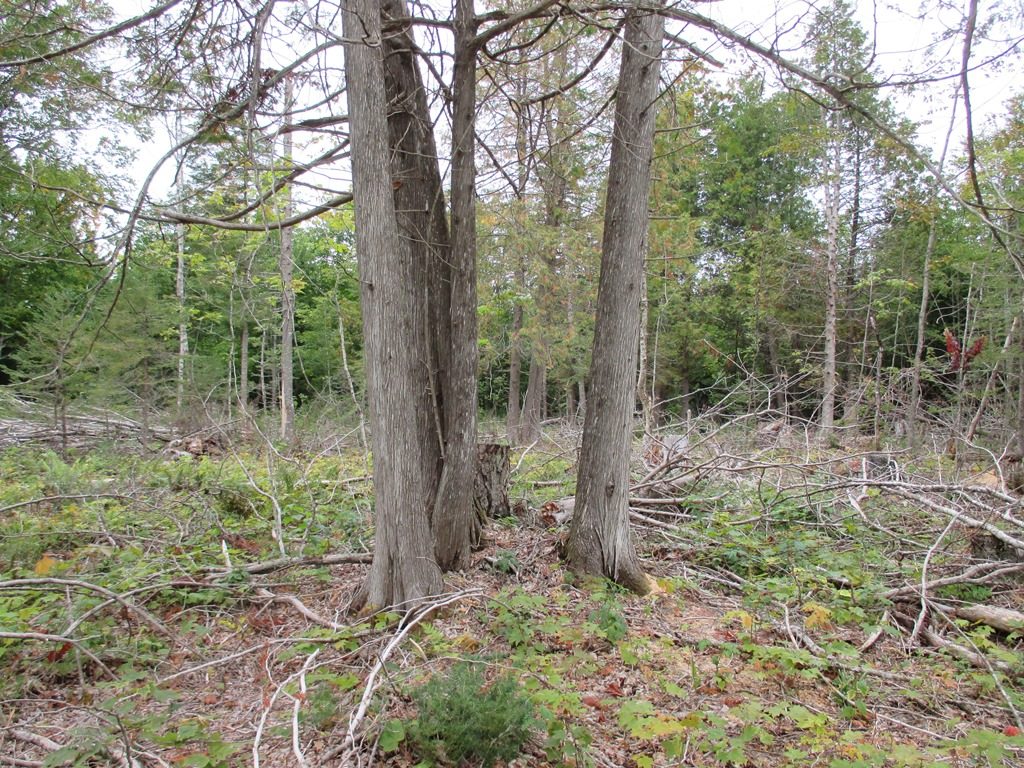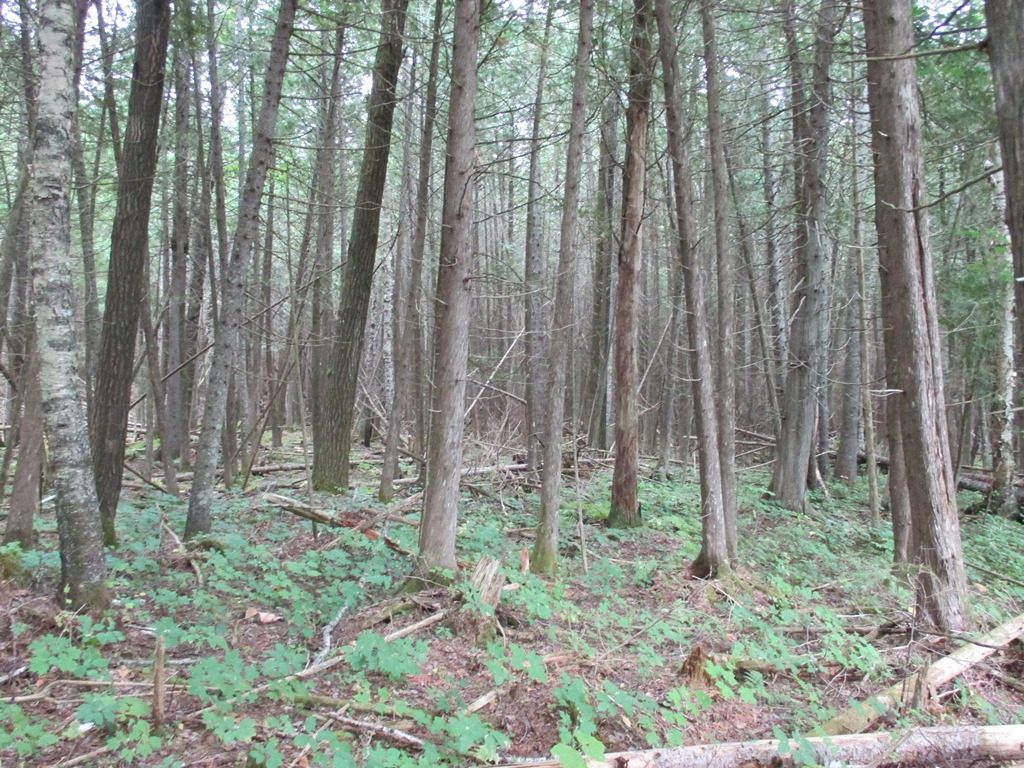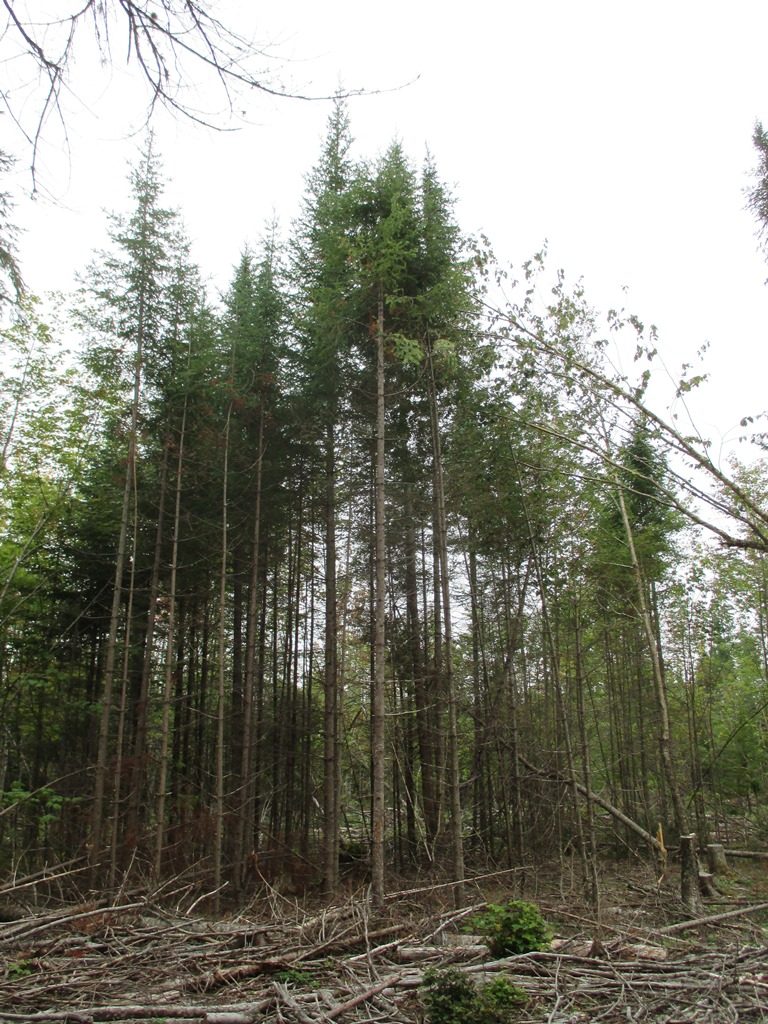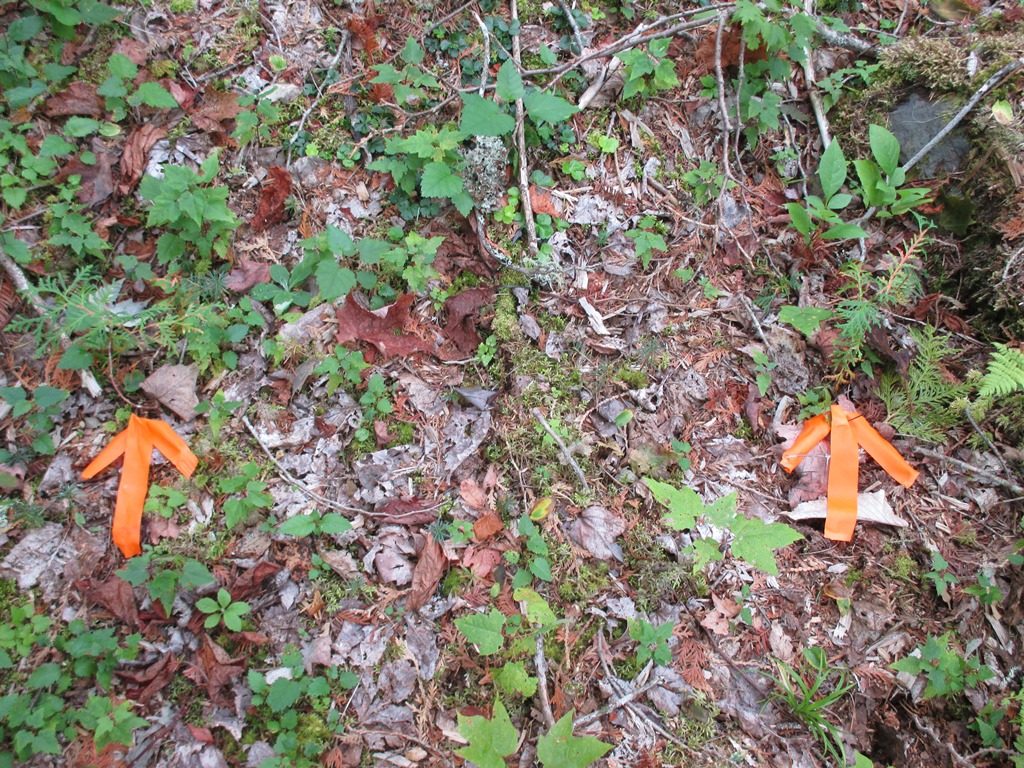September 29, 2016 at 4:37 pm
By IFW Wildlife Biologist Scott McLellan
[caption id="attachment_1963" align="alignright" width="318"] This photo (figure 1) shows a harvest block where a number of the white cedar trees were retained.[/caption]
As a regional biologist, one of our responsibilities is working with landowners to manage deer wintering areas (DWA’s). White-tailed deer are at the northern edge of their range here in Maine, and these deer wintering areas are critical for the overwintering survival of whitetail deer, and thus important in the long-term management of this species.
We work very hard to develop mangement plans for these wintering area, and often times, part of these plans includes a partial timber harvesting regime that aims to improve the softwood component of the area. To help us gain a better understanding of the success of each harvest, we make follow-up visits to the site to evaluate the job. This includes, but is not limited to: Walking many of the skid trails to study/identify stumps, assessing the quantity and quality of residual stems, and identifying the percent of softwood regeneration resulting from the harvest.
[caption id="attachment_1964" align="alignleft" width="319"]
This photo (figure 1) shows a harvest block where a number of the white cedar trees were retained.[/caption]
As a regional biologist, one of our responsibilities is working with landowners to manage deer wintering areas (DWA’s). White-tailed deer are at the northern edge of their range here in Maine, and these deer wintering areas are critical for the overwintering survival of whitetail deer, and thus important in the long-term management of this species.
We work very hard to develop mangement plans for these wintering area, and often times, part of these plans includes a partial timber harvesting regime that aims to improve the softwood component of the area. To help us gain a better understanding of the success of each harvest, we make follow-up visits to the site to evaluate the job. This includes, but is not limited to: Walking many of the skid trails to study/identify stumps, assessing the quantity and quality of residual stems, and identifying the percent of softwood regeneration resulting from the harvest.
[caption id="attachment_1964" align="alignleft" width="319"] This cedar stand (figure 2), which was left intact, will provide both cover and browse for white-tailed deer.[/caption]
The pictures here help illustrate how we manage these deer wintering areas. Figure 1 portrays a harvest block showing the retention of northern-white cedar trees, which is a critical harvest objective, since they provide both cover and some browse. Figure 2 shows a cedar-dominated stand that was not entered at all to protect its value. Figure 3 depicts advanced regeneration that was retained to supply deer with the next generation of cover. Finally, figure 4 reveals 2 cedar seedlings that possibly germinated as a result of the harvest. These partial harvests will again be visited in the future to document winter deer use and harvest success.
[caption id="attachment_1965" align="alignleft" width="535"]
This cedar stand (figure 2), which was left intact, will provide both cover and browse for white-tailed deer.[/caption]
The pictures here help illustrate how we manage these deer wintering areas. Figure 1 portrays a harvest block showing the retention of northern-white cedar trees, which is a critical harvest objective, since they provide both cover and some browse. Figure 2 shows a cedar-dominated stand that was not entered at all to protect its value. Figure 3 depicts advanced regeneration that was retained to supply deer with the next generation of cover. Finally, figure 4 reveals 2 cedar seedlings that possibly germinated as a result of the harvest. These partial harvests will again be visited in the future to document winter deer use and harvest success.
[caption id="attachment_1965" align="alignleft" width="535"] Figure 3 shows the advanced regeneration of a softwood stand.[/caption]
[caption id="attachment_1966" align="alignleft" width="711"]
Figure 3 shows the advanced regeneration of a softwood stand.[/caption]
[caption id="attachment_1966" align="alignleft" width="711"] These arrows in figure 4 show two cedar seedlings that most likely germinated as a result of the harvest.[/caption]
These arrows in figure 4 show two cedar seedlings that most likely germinated as a result of the harvest.[/caption]
 This photo (figure 1) shows a harvest block where a number of the white cedar trees were retained.[/caption]
As a regional biologist, one of our responsibilities is working with landowners to manage deer wintering areas (DWA’s). White-tailed deer are at the northern edge of their range here in Maine, and these deer wintering areas are critical for the overwintering survival of whitetail deer, and thus important in the long-term management of this species.
We work very hard to develop mangement plans for these wintering area, and often times, part of these plans includes a partial timber harvesting regime that aims to improve the softwood component of the area. To help us gain a better understanding of the success of each harvest, we make follow-up visits to the site to evaluate the job. This includes, but is not limited to: Walking many of the skid trails to study/identify stumps, assessing the quantity and quality of residual stems, and identifying the percent of softwood regeneration resulting from the harvest.
[caption id="attachment_1964" align="alignleft" width="319"]
This photo (figure 1) shows a harvest block where a number of the white cedar trees were retained.[/caption]
As a regional biologist, one of our responsibilities is working with landowners to manage deer wintering areas (DWA’s). White-tailed deer are at the northern edge of their range here in Maine, and these deer wintering areas are critical for the overwintering survival of whitetail deer, and thus important in the long-term management of this species.
We work very hard to develop mangement plans for these wintering area, and often times, part of these plans includes a partial timber harvesting regime that aims to improve the softwood component of the area. To help us gain a better understanding of the success of each harvest, we make follow-up visits to the site to evaluate the job. This includes, but is not limited to: Walking many of the skid trails to study/identify stumps, assessing the quantity and quality of residual stems, and identifying the percent of softwood regeneration resulting from the harvest.
[caption id="attachment_1964" align="alignleft" width="319"] This cedar stand (figure 2), which was left intact, will provide both cover and browse for white-tailed deer.[/caption]
The pictures here help illustrate how we manage these deer wintering areas. Figure 1 portrays a harvest block showing the retention of northern-white cedar trees, which is a critical harvest objective, since they provide both cover and some browse. Figure 2 shows a cedar-dominated stand that was not entered at all to protect its value. Figure 3 depicts advanced regeneration that was retained to supply deer with the next generation of cover. Finally, figure 4 reveals 2 cedar seedlings that possibly germinated as a result of the harvest. These partial harvests will again be visited in the future to document winter deer use and harvest success.
[caption id="attachment_1965" align="alignleft" width="535"]
This cedar stand (figure 2), which was left intact, will provide both cover and browse for white-tailed deer.[/caption]
The pictures here help illustrate how we manage these deer wintering areas. Figure 1 portrays a harvest block showing the retention of northern-white cedar trees, which is a critical harvest objective, since they provide both cover and some browse. Figure 2 shows a cedar-dominated stand that was not entered at all to protect its value. Figure 3 depicts advanced regeneration that was retained to supply deer with the next generation of cover. Finally, figure 4 reveals 2 cedar seedlings that possibly germinated as a result of the harvest. These partial harvests will again be visited in the future to document winter deer use and harvest success.
[caption id="attachment_1965" align="alignleft" width="535"] Figure 3 shows the advanced regeneration of a softwood stand.[/caption]
[caption id="attachment_1966" align="alignleft" width="711"]
Figure 3 shows the advanced regeneration of a softwood stand.[/caption]
[caption id="attachment_1966" align="alignleft" width="711"] These arrows in figure 4 show two cedar seedlings that most likely germinated as a result of the harvest.[/caption]
These arrows in figure 4 show two cedar seedlings that most likely germinated as a result of the harvest.[/caption]Categories